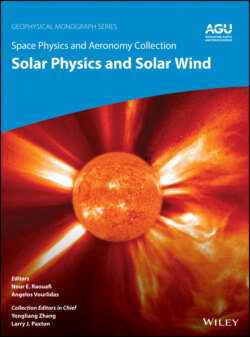Читать книгу Space Physics and Aeronomy, Solar Physics and Solar Wind - Группа авторов - Страница 26
1.5.3. Suprathermal Particles
ОглавлениеKinetic effects induce strong distortions of the VDFs in the thermal regime, but also by forming suprathermal populations that include electron strahl, non‐thermal ion beams, and heavy ion differential streaming. In this chapter, we focus on the origin and important effects of suprathermal electrons and direct the reader to the review by Marsch et al. (2009) for a discussion of suprathermal ions.
As already mentioned, solar wind electron distributions show distinct particle populations; a thermal core; an extended suprathermal halo; the asymmetric, anti‐sunward strahl; and an isotropic super‐halo at higher energies (Lin, 1998). The thermal core can be described by a bi‐Maxwellian distribution, but this does not work so well for the halo (Pilipp et al., 1987) component. Core and halo can be much better fitted by kappa distributions (Maksimovic et al., 1997), that show power‐law suprathermal tails ∝v −2( κ + 1). The κ parameter can reach values as low as 2. Note that κ → ∞ corresponds to a Maxwellian, and for κ → 1.5, the thermal energy, that is, the temperature, diverges.
An even better fit to observed electron data can be achieved if the core is additionally fitted by a (bi‐)Maxwellian (Pierrard et al., 2016). The density of the halo is less than that of the core, but due to the higher halo temperature, their thermal energies are comparable (Maksimovic et al., 2000). A coronal origin of these suprathermal electrons is possible (Pierrard et al., 1999; Vocks et al., 2005), but whistler wave turbulence in the solar wind also plays a role in shaping these distributions (Yoon et al., 2015).
Pierrard et al. (2016) have studied the evolution of the suprathermal halo through the heliosphere between 0.3 AU and 4 AU. Temperature anisotropies were considered by applying bi‐kappa fits to the electron halo population. As already found in earlier works (Maksimovic et al., 1997), the kappa value, and thus the strength of the suprathermal population, is not constant but varies in time with solar wind conditions.
Throughout the heliosphere, the kappa of the halo population generally decreases with increasing solar distance. Values of κ = 7 are frequently found closer than 1 AU, but rarely beyond 1 AU. A similar trend is found for kappa values around 5, and κ = 3 is hardly found below 1.5 AU, and more frequently beyond 1.5 AU. The strahl population can follow a different trend.
This reduction of kappa corresponds to an increase in kinetic temperature. Therefore, some mechanism for energizing these electrons has to be present in the solar wind.
The presence of non‐thermal populations in many space plasmas suggests a universal mechanism for their creation. This concerns mainly electrons, but also the ions in the solar wind. Observations of electron suprathermal tails in the solar wind suggest their existence in the solar corona, because the electron mean free path in the solar wind is around 1 AU. The ion‐charge measurements also confirm that suprathermal electrons can already be present in the corona. In any case, measurements made by Helios a radial distances as low as 0.3 AU confirm the presence of suprathermal electrons, even if they are characterized by a larger kappa index for the halo population at low radial distances (Pierrard et al., 2016). Solar Orbiter will have the advantage of measuring the distributions at low distances inside and outside the ecliptic plane. Up to now, the distributions at low distances have come from Helios, and those at large distances from Ulysses. Even if useful to study the average evolution with the radial distances, the observations were made at very different time periods (1970s for Helios, 1990s for Ulysses) and by different instruments measuring the distributions on different energy ranges.
Different scenarios have been suggested to generate the suprathermal particles (see Pierrard & Lazar, 2010, for a review). Turbulence associated with the long range of the Coulomb interactions has been proposed. Models including the generation of suprathermal electrons by resonant interaction with whistler waves in the solar corona and wind have been developed (Pierrard et al., 2011; Vocks & Mann, 2003). Recent scenarios use the kinetic theory to show that Kappa‐like distributions could correspond to a particular thermodynamic equilibrium state. Kappa‐like distributions can result as a consequence of the entropy generalization in nonextensive statistics (Leubner & Vörös, 2005), physically related to the long‐range nature of the Coulomb potential, turbulence, and intermittency.
Suprathermal particles have important consequences for plasma fluctuations, resonant and nonresonant wave–particle acceleration, the heat flux, and plasma heating. These effects are well described by the kinetic approaches, where no closure requires the distributions to be nearly Maxwellian. The heating of the corona can be naturally explained by the velocity filtration, without depositing wave or magnetic field energy. Indeed, if suprathermal particles are present, their ratio over thermal ones increases as a function of altitude in an attraction field and automatically lead to an increase in temperature. This process works for electrons, but also protons and other ions if they are characterized by an enhanced population of suprathermal particles already in the low corona. The mass‐to‐charge ratio then determines the temperature of each ion species in good agreement with observations (Pierrard & Lamy, 2003). At larger radial distances (typically above 1.5 solar radii), the wind starts to blow, and the temperature reaches a maximum before starting to decrease. The presence of suprathermal electrons also increases the solar wind velocity as shown by Pierrard and Pieters (2014), in comparison to what is obtained with a simple thermal population characterized by a Maxwellian distribution.
